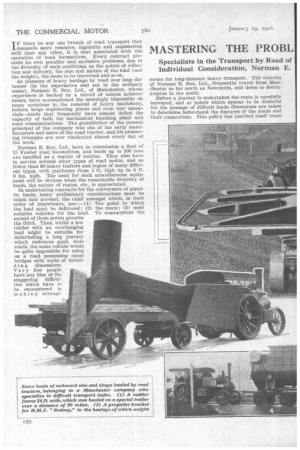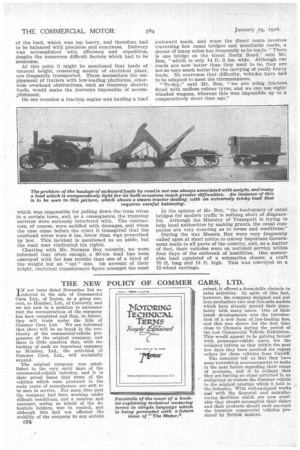MASTERING THE PROBL THE AWKWARD LOAD.
Page 16

Page 17

Page 18

If you've noticed an error in this article please click here to report it so we can fix it.
Specialists in the Transport by Road of Individual Consideration, Norman E. Mfficult Loads,. Each of which Requires 'Relate Some of Their Experiences.
IF there be any one branch of road transport that demands more resource, ingenuity and engineering skill than any other, it is that associated with the operation of road locomotives. Every contract presents its own peculiar and exclusive problems, due to the diversity of such conditions, as the points of collection and delivery, the size and nature of the load (not the weight), the route to be traversed and so on.
As pioneers of heavy haulage by road over long distances (in the superlative and not in the ordinary sense), Norman E. Box, Ltd., of Manchester, whose experience is backed by a record of unique achievements, have accomplished the seemingly impossible on many occasions in the removal of heavy machinery, boilers, large engineering pieces and even war memorials—loads that frequently have almost defied the capacity of both the mechanical handling plant and road communications. The grandfather of the present principal of the company was one of the early manufacturers and users of the road tractor, and his pioneering triumphs are now vindicated almost etery day of the week.
Norman E. Box, Ltd., have in commission a fleet of 15 Fowler road locomotives, and loads up to 100 tons are handled as a matter of routine. They also have in service several other types of road motor, and no fewer than 60 heavy trailers and bogies of many different types, with platforms from 1 ft. high up to 4 ft. 6 ins. high. The need for such miscellaneous equipment will be obvious when the remarkable diversity of loads, the nature of routes, etc., is appreciated.
In undertaking contracts for the conveyance of gigantic loads, many preliminary considerations must be taken into account, the chief amongst which, in their order of importance, are :—(1) The point to which the load must be delivered ; (2) the route; (3) most suitable vehicles for the load. To somev extent the second of these points governs the third. Thus, whilst a low trailer with an overhanging load might be suitable for undertaking a long journey which embraces good, wide roads, thesame vehicle would be quite impossible for using on a road Possessing canal bridges with walls of forbidding dimensions. V er y few people have any idea of the staggering difficulties which have to be encountered in m ark i n g arrange meats for long-distance heavy transport. The vehicles 9f Norman E. Box, Ltd., frequently travel from Manchester so far north as Newcastle, and down to Southampton in the south.
Before a journey is undertaken the route is carefully surveyed, and at points which appear to be doubtful for the passage of difficult loads dimensions are taken to determine beforehand the features of the roads and their connections. This policy has justified itself times without number. Not only that, but whenever a big and important load is in transit a scout always proceeds ahead of the tractor to warn and prepare other road users of the traffic which is likely to be met. • It is not an unusual thing, even if it be not so extraordinarily common, for engineers and machinery builders to complete their 'part, of an order and trust to the ingenuity of the transport man to deliver the plant to the spot where it is 'required. Power stations have actually been built without details having been decided as to the means by which some of the massive machinery was to be installed. On the other hand, constructors of big piece of metalwork, realizing the problem of transporting heavy and awkward loads, have consulted the contractor before putting the work in hand to make certain, at the outset, that delivery is possible.
Much of the heavy transport undertaken by Norman E. Box, Ltd., could not be performed by railway. Support for this statement can be found in some of the accompanying illustrations. One of these 'shows a load —heavy, although not remarkable for weight—consisting of a rudder frame 24 ft. wide. This was conveyed from Sheffield to a place 80 miles distant, and delivery, for which much pre-arrangement was made, was completed without mishap. To enable the journey to be undertaken, scores of lamp-posts aud telegraph poles had to be removed and subsequently re-erected. Even walls had to be knocked down and rebuilt after this record journey had been completed.
This is one of the most awkward loads with which Messrs. Box have ever had to deal, and that the journey should_ have been accomplished so successfully is, indeed, a tribute to their skilful execution of the contract. It will be seen that the projections of the frame are surrounded by a protecting plate. The load was lashed on a high trailer at a distance from the ground sufficient to permit of a motorcar to pass underneath. This load was one of the fittings for H.M.S. "Rodney," which was launched by Princess Mary two or three weeks ago.
A. companion picture shows the propeller bracket for the same battleship. This was an equally difficult load to handle, not so much because of the big overhang as the necessity for arranging an equal distribution of 'weight on each of the axles. The load rested on the bogie at three points, and was packed up in the.centre.
Still moreperplexing to tackle was the load shown in the picture reproduced on the next page. Here weight was secondary to th2 awkward shape of the load, which was top heavy, and therefore had to be balanced with precision and exactness. Delivery was accomplished with efficiency and expedition, despite the numerous difficult factors which had to be overcome.
At this point it might be mentioned that loads of unusual height, consisting mainly of electrical plant, are frequently transported. These necessitate the employment of trailers with low-loading platforms, otherwise overhead obstructions, such as tramway electric feeds, would make the journeys impossible of accomplishment.
On one occasion a traction engine was hauling a load which was responsible for pulling down the tram wires in a certain town, and, as a consequence, the tramway services were seriously interfered with. The contractors, of course, were saddled with damages, and when the case came before the court it transpired that the overhead wires were 9 ins, lower than was prescribed by law. This incident is mentioned as an aside, but the road user vindicated his rights.
Chatting with Mr. Norman Box recently, we were informed that often enough a 90-ton load has been conveyed with far less trouble than one of a third of the weight but an " out " size. On account of their height, electrical transformers figure amongst the most
awkward loads, and when the direct route involves traversing -low canal bridges and unsuitable roads, a detour of many miles has frequently to be made. "There is one bridge on the Great North Road," said Mr. Box, "which is only 14 ft. 3 ins. wide. Although our roads are now better than they used to be, they are not so very much better for the carrying of really heavy loads. To overcome that difficulty, vehicles have had to be adapted to meet the circumstances.
"To-day," said Mr. Box, "we are using tractors. fitted with endless rubber tyres, and we can use eightwheeled wagons, whereas this was impossible up to a comparatively short time ago."
In the opinion of Mr. Box, "the inadequacy of canal bridges for modern traffic is nothing short of disgraceful. Although the Ministry of Transport is trying to help local authorities by making grants, the canal companies are very exacting as to terms and conditions."
During the war Messrs. Box were very frequently called upon at short notice to convey important Government loads to all parts of the country, and, as a matter of fact, their vehicles were on national s.ervice within four days of the outbreak of hostilities. One memorable load consisted of a submarine chaser, a craft 70 ft. long and 14 ft. high. This was conveyed on a 12-wheel carriage.






























